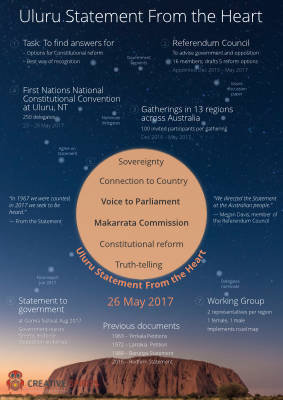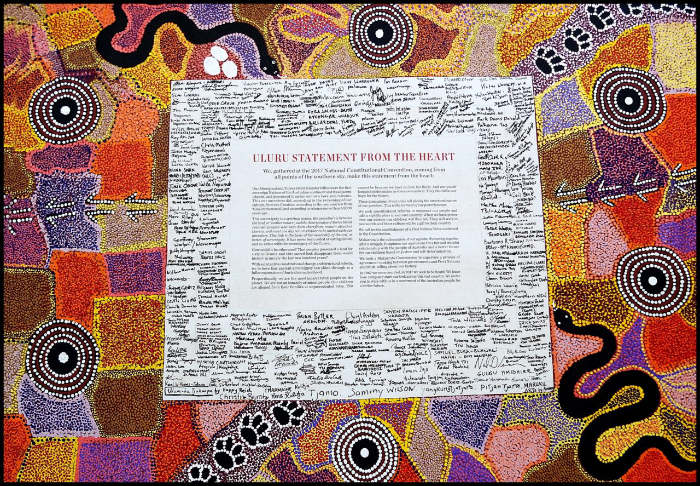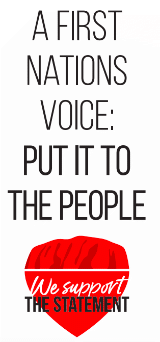Self-determination
Explainer: Uluru Statement from the Heart
For the first time Aboriginal people formed a united position and gave a single key recommendation to the Australian government. Read a summary, what it its & who wrote it.

Wishing you knew more about Aboriginal culture? Search no more.
Get key foundational knowledge about Aboriginal culture in a fun and engaging way.
This is no ordinary resource: It includes a fictional story, quizzes, crosswords and even a treasure hunt.
Stop feeling bad about not knowing. Make it fun to know better.
Selected statistics
- 2017
- Year the Uluru Statement From the Heart was published.
- >250
- Number of Aboriginal delegates who gathered at Uluru to agree on the statement.
-
93% - Percentage of Aboriginal people who say it is important to undertake formal truth-telling processes about Australian history; figure for non-Aboriginal Australians: almost 90%. [1]
What is the the Uluru Statement from the Heart?

The Statement is a document Aboriginal people from all over Australia agreed on. In it they express that they are a sovereign people, and what they want all Australians to do to recognise and support this sovereignty. It also comments on the social difficulties faced by Aboriginal people.
The Uluru Statement is a message for people like you and me: "It is not a submission or a petition to the government. It is an invitation to you, the Australian people," says Dean Parkin, a Quandamooka man and one of the signatories.
It is not the first time Aboriginal people crafted such a document, but probably the first time Aboriginal people form a united position and a single key recommendation, or, as The Guardian put it, "the largest ever consensus of Aboriginal and Torres Strait Islander people on a proposal for substantive recognition". [2]
While previous documents of Aboriginal aspirations were usually addressed to the Parliament, the Uluru Statement From the Heart is directed to the Australian public.
“We meaningfully and consciously gave the Uluru Statement From the Heart as a gift to the to the Australian people,” explains Pat Anderson, an Alyawarre woman from the Northern Territory. “It’s a gift of healing. And indeed love. We don’t often like to use that word. But, you know, it’s a very, very emotional document.” [3]
In 2021, the Uluru Statement From the Heart was awarded the Sydney Peace Prize. The judges saw it as a “clear and comprehensive agenda for healing and peace within our nation”. [3]
Get my infographic explainer about the Uluru Statement From the Heart to understand how it came about.
The Uluru Statement from the Heart stands as the most important piece of political writing produced in Australia in at least two decades.
— Australian Broadcasting Corporation [4]
Who wrote the Statement?
From 23 to 26 May 2017, more than 250 Aboriginal delegates from all over Australia gathered at Uluru, Northern Territory, on the lands of the Anangu people, at the First Nations National Constitutional Convention. They had previously been selected at gatherings in 12 regions around Australia.
Their task was to identify amendments required for constitutional recognition of Aboriginal people.
Do all Aboriginal people support the Uluru Statement?
No. Aboriginal people are diverse as any other group, and some believe the statement does not go far enough. There is no unified "Aboriginal view" of the statement. But you can assume that a strong proportion of Aboriginal people support it.

Key elements of the Uluru Statement from the Heart
On the last day of the convention they wrote the Uluru Statement from the Heart. Its key elements are: [6][7]
- Sovereignty. Acknowledgement that Aboriginal tribes were the first sovereign nations of the Australian continent, that sovereignty was never ceded and that it co-exists with the sovereignty of the Crown.
- Constitutional reform. Constitutional reforms would empower Aboriginal people to manage their own affairs and righten the current skewed statistics for e.g. incarceration or suicide.
- Makarrata Commission. A Makarrata (Treaty) Commission would have two roles: Develop a national framework that would permit each sovereign Aboriginal nation state to negotiate their own respective treaty; and oversee a process of truth-telling. Similar commissions (including truth telling) are common throughout the world and have been established in countries such as Canada, New Zealand and South Africa. [8]
- Truth-telling, a process that exposes the full extent of the past injustices experienced by Aboriginal people. Importantly, it empowers Aboriginal people to no longer be a subject in the dialogue about Aboriginal history, but instead be the voice telling this history. It would allow all Australians to understand Aboriginal and Australian history, and assist in moving towards genuine reconciliation. [9] (See the Treaty timeline for more details.)
- Voice to Parliament. Establishment of an elected voice to the Parliament with constitutional backing. This voice would be empowered to give Aboriginal people a say in laws that affect them. It would be a voice that cannot be removed unless by a future constitutional referendum.
Should Indigenous people have a formal Voice to Parliament?
- Yes
- 74%
- No
- 17%
- Unsure
- 9%
SMH 13/7/2020; 3,299 votes
Some key elements of a Voice to Parliament are: [10]
- It will not have a veto right of the parliament nor could it legally challenge any parliamentary process.
- It will advise the Federal Parliament about laws and policies that impact the lives of First Nations peoples.
- Parliament and government would be obliged to consult it on matters that overwhelmingly relate to First Nations peoples.
- It will not deliver any programs (like ATSIC did), do research or manage funds.
It is important to note that the Voice to Parliament should be guaranteed by the constitution. Previous Aboriginal representative bodies (such as the Aboriginal and Torres Strait Islander Commission, ATSIC) that had been set up only in laws were easily abolished by successive governments depending on their priorities. The constitutional guarantee aims to provide stability and longevity, but requires a change to the Constitution. The Uluru Statement is deliberately scarce on how to implement this voice, as future legislation would set up details, functions, powers and processes.
56% - Percentage of surveyed Australians who supported a Voice to Parliament in 2020. [11]
71% - Percentage of Aboriginal people who supported a Voice to Parliament. [11]
Is the sequence – Voice, Treaty, Truth – important?
An obvious suggestion is to first tell the truth about First Nations experiences to then base a voice and treaty on this shared history. But some First Nations people disagree, reflecting their diversity of opinions.
Official bodies representing First Nations voices experienced sudden deaths in the past. The Howard government terminated the Aboriginal and Torres Strait Islander Commission (ATSIC) after 15 years of operation in 2004, and a newly elected Liberal government in South Australia stopped the state’s treaty process in March 2018.
While for some securing a voice to Parliament is the first priority, others, such as Senator Lidia Thorpe see a treaty as more important than a voice or constitutional recognition. "The Voice proposal does not deliver any land, resources or empowerment, because it only advises," agrees Michael Mansell, chair of the Tasmanian Aboriginal Land Council. "Treaty should come before Voice." [12]
The Statement's artwork
The artwork of the Statement shows two creation stories of the Anangu people who are the traditional custodians of Uluru.
One is the story of Kuniya (top left), a female python with eggs from the north-east, and Liru (bottom right), the poisonous snake from the south-west. Both ancestors are involved in a fight to the death at the Mutitjulu spring, which then shapes Uluru's landscape.
The second story is that of the Mala people, represented by rufous hare-wallaby prints, who were holding a ceremony atop Uluru when they became involved in a dispute with men who approached from the west. Those men went away and created Kurpany, the Devil Dingo, represented by the dog prints. [13]
Note that the word 'Uluru' relates to one specific family group of the Anangu people who share responsibility for the rock. That family has already protested against the use of their name for the statement as it is exclusive of others. They prefer just 'Statement From the Heart'.
91% of surveyed Aboriginal people and 80% of Australians in the general community believe it is important to undertake formal truth-telling processes in relation to Australia's shared history. [14]
Some consider former prime minister Paul Keating's Redfern Speech as the beginning of truth-telling.
In 1967 we were counted, in 2017 we seek to be heard.
— From the Uluru Statement from the Heart
Video: Voice, Treaty, Truth
Listen to Waka Waka man and singer-songwriter James Williams and his interpretation of the Uluru Statement From the Heart and what it means for us.
Homework: "Wait, isn't a voice to Parliament racist?"
Some believe that a constitutionally enshrined voice to Parliament gives an unfair advantage to Aboriginal people and is thus racist.
But the determinant is time-based, not race-based, like many other examples of legal discrimination in Western law:
- the legal age to vote,
- when you can first get a drivers license,
- the legal age to get married,
- eligibility for a pension, etc.
Similarly, anyone whose ancestors lived in Australia before 1788 and suffered the theft of their lands and its intergenerational consequences is eligible for a voice to Parliament.
Questions
- Find as many time-based examples of legal discrimination as you can.
- Explore how people who don't qualify for the benefit might see these rules as discriminatory.
- Put yourself into the shoes of an Aboriginal person. What should a voice to Parliament call for first?
What led to the Statement?

The Statement was the culmination of intensive 6-month dialogues between December 2016 and May 2017 in 13 regions around Australia with one hundred invited participants each.
The regions were Adelaide, Brisbane, Broome, Cairns, Canberra, Dubbo, Darwin, Hobart, Melbourne, Perth, Ross River, Sydney and Thursday Island.
All of these gatherings went over 3 days, were designed and led by Aboriginal people, and organised by the Indigenous Steering Committee of the Referendum Council.
Armed with information about the Constitution and the history of constitutional reform, participants were able to discuss and assess 5 different reform options in an informed manner, and to explain what meaningful reform would look like for their communities.
The five reform options discussed were: [15]
- A statement that acknowledges the First Peoples of Australia;
- A voice to Parliament, i.e. a new group of Aboriginal people who give advice to the Parliament about Aboriginal issues;
- Replace or update Section 51 ("race power") of the Constitution to remove the race bias;
- Remove Section 25 from the Constitution which allows States to ban people of any race from voting;
- Add a new section in the Constitution to stop Parliament from being able to make laws that discriminate against people of any race or culture.
At the end of the gatherings, delegates confirmed a statement of their discussion and selected representatives for the Uluru meeting.
The dialogues were preceded by a long-running political debate over how to achieve constitutional reform and how to recognise Aboriginal people meaningfully and not just symbolically. For many decades Aboriginal advocates have asked to be heard, and have a say, in political decisions made about their rights and interests.
The Uluru Statement joins other important statements Aboriginal people made, calling for recognition and sovereignty, for example the
- 1963 Yirrkala bark petitions,
- 1972 Larrakia Petition,
- 1988 Barunga Statement, or
- 2016 Redfern Statement.
How was the Statement received?
About a month after the Uluru meeting, the Referendum Council delivered its final report to both the prime minister and the leader of the opposition.
It recommended a referendum to include a representative body (voice to Parliament) in the Australian Constitution and a national declaration of recognition outside of the Constitution as a "symbolic statement of recognition". [16]
Members of the Referendum Council presented the Uluru Statement – now a large painted and signed canvas – personally to the prime minister and opposition leader at the Garma Festival in north-east Arnhem Land in August 2017.
Prime minister's response
After "carefully" considering the Uluru Statement from the Heart, the prime minister, Malcolm Turnbull, believed that a voice to Parliament would not be "either desirable or capable of winning acceptance in a referendum" and rejected the Statement five months after it was issued.
He feared that the representative body "would inevitably become seen as a third chamber of Parliament", [17] a concern first voiced by his deputy prime minister, Barnaby Joyce, who later apologised "unreservedly" for "getting it wrong". [18]
The prime minister also noted the scarcity of details around representation and election of members. He did not believe that "such a radical change to our constitution’s representative institutions has any realistic prospect of being supported by a majority of Australians".
Opposition's response
The opposition leader backed a constitutionally-enshrined 'Voice to Parliament', a national declaration of recognition and truth-telling commission.
He proposed a bipartisan parliamentary committee to finalise the recommendations and expressed hope to complete a referendum proposal by the end of 2017. [19]
Other responses
The Australian Greens "strongly support" the Uluru Statement from the Heart in a media release in May 2017. [20]
Australian mining giants BHP and Rio Tinto released a joint statement in January 2019 supporting the Uluru Statement From the Heart, "because all of our operations are on Aboriginal lands". The two businesses were the first Australian companies to publicly endorse the statement. BHP pledged about $1m to raising awareness among Australians about the Aboriginal voice to parliament. [21]
By May 2019, 14 Australian companies pledged their support in a Response to the Uluru Statement, supporting the call for a referendum to enable constitutional reform and encouraging others to join the national dialogue. [22]
The longer I’ve been at BHP, the more certain I’ve become that this great company, like this great country, has unfinished business with the Indigenous peoples of Australia.
— Andrew Mackenzie, BHP chief executive [21]
Why the Uluru Statement doesn't talk about a referendum
Many treaty discussions emphasise that a referendum is needed for the treaty process. But this is not the case.
The Elders who wrote the Uluru Statement From the Heart are asking Australian politicians to write, introduce, and pass, a Treaty Act. A referendum is unnecessary because the parliament has the power to pass any act.
The Elders at Uluru didn’t ask for, and in their discussions firmly rejected, a referendum. They feared that referendum-based changes to the Constitution would only perpetuate the UK Crown's domination of Aboriginal people and void Aboriginal sovereignty which they never ceded.
That is why the Uluru Statement From the Heart never mentions a referendum. [23]
Video: The Uluru Statement – An idea whose time has come
Dean Parkin, a Quandamooka man from Minjerribah (North Stradbroke Island), is one of the signatories of the Uluru Statement. In this 20-minute video at TEDx Canberra, he shares his personal experience while working at the Uluru gathering. And he clarifies:
"There's a reason why this Statement is with me on this stage today," he says. "It is not a submission or a petition to the government. It is an invitation to you, the Australian people."
Next steps & resources
During the gathering at Uluru, each region elected two people, one male and one female, to form the national Uluru Statement Working Group.
The working group is tasked to implement a roadmap and discuss how to achieve the spirit and intent of the Uluru Statement from the Heart.
Read (or listen to) the Uluru Document from the Heart in full or download it.
You can also check if it has been translated into your language (64 translations are available).
ABC offers three Boyer lectures (about 25 minutes each) from Rachel Perkins where she explains the background and importance of the Uluru Statement From the Heart.
The Indigenous Constitutional Law Blog offers commentary from experts across Australia on the reforms contained in the Uluru Statement from the Heart. The blog is written for the Australian public, and contains accessible legal and political analysis as well as a short timeline.
Despite all this disappointment there is a determination to remain hopeful. And this is the fuel that fires the Uluru Statement From the Heart – hope.
— Rachel Perkins [24]